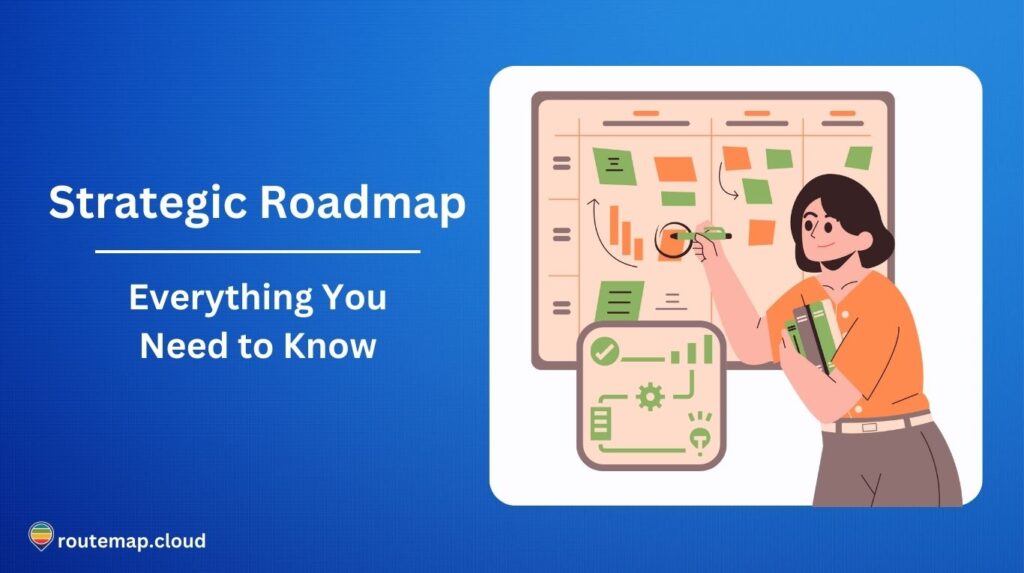If your execution falls short, there will be no salvation regardless of how well-made your plan is. That is also the reason why a strategic roadmap always comes along with or right after a plan is developed.
Strategic roadmaps help team leaders understand and plan how to achieve strategic goals while explaining their business vision to the stakeholders.
What is a strategic roadmap?
To every organization, a strategic plan is a must to help define the company’s vision, goals, and objectives to grow. However, to visualize this plan and turn it into reality, a strategic roadmap comes in to take the lead.
Typically, a strategic roadmap contains several main components, such as:
- Vission
- Mission
- Goals
- Strategies
- Tactics
- Key performance indicators (or KPIs)

Besides visualizing, a strategic roadmap also plots out activities, tasks, timelines, resources needed, and more to help organizations achieve their vision. Every member can use this strategy roadmap to prioritize their work, allocate resources, and align team members toward the same goals.
Why is a strategy roadmap important?
To answer this question, let’s consider its converse: “What would happen if an organization does not develop a strategic roadmap?”
Keep in mind, a roadmap is somewhat like a record of activities in the past, present, and future, identifying the key events and milestones to achieve the desired goals. Without one, businesses can face numerous difficulties when there are sudden changes during the process.
They can be lost and confused about what needs to be done next, from aligning teams and prioritizing tasks to communicating effectively. And if businesses fail to adapt to the situation, they may ultimately fail to reach their final goal.
With these in mind, the importance of a strategic roadmap is nowhere to be doubted. It helps businesses stay ahead of the competition by setting clear goals and objectives. Besides, strategic roadmaps also allow businesses to realize what they did well in the past and what needs to be improved.
What is the difference between a strategic roadmap vs a plan?
Although a strategic roadmap and a plan are closely related, they have some main differences.

A strategic roadmap is a visual presentation of the company’s strategy, outlining key objectives, initiatives, and milestones required to achieve its goals. It usually conveys a longer time range and provides a bigger picture of the company’s vision.
Meanwhile, a plan is a detailed set of actions and tactics developed to achieve a specific goal. Besides, it is more likely to have a shorter time range and more details than a strategic roadmap.
Another main difference between the two is that a strategic roadmap tends to be more flexible than a plan as it is designed to be updated depending on the changing conditions. A plan, on the other hand, requires a more detailed execution.
How to develop a strategic roadmap
Now that you have understood the importance of strategic roadmaps and their difference from plans, you can create one and apply it to any process.
However, you should always remember to link strategic roadmap objectives to the business vision to avoid going sideways.
1. Understand your challenges
The first step in developing a strategic roadmap is that you have to answer the question of what your challenges are. Once you have pinpointed these challenges, you can then define opportunities and ways to overcome them.
2. Set your short-term goals
For each challenge, you will have to develop a specific goal or objective. It is usually short-term in your long-term strategic plan so it can adapt to any sudden changes. After that, you can work your way to achieve them.
Keep in mind that each objective must clearly link to a corresponding challenge AND a specific goal of your business vision.
3. Assess your resources
At this point, you should be addressing the resources such as employees, budget, time, technology, or more, and see if such resources are enough to achieve your goals. And if not, you will need to adjust your plan or find more resources to back up.
Moreover, you should keep relevant KPIs in mind when assessing your resources. You may want additional software or tools to assess the service levels if you want to keep track of customer acquisition.
You can utilize the following change indicators to mark your resource status when there is a change required.
- Nothing (N): No change is needed.
- Low (L): A low level of change is needed.
- Medium (M): A medium level of change is needed.
- High (H): A high level of change is needed.
- New: A new capability is needed to make a change.
4. Plan your actions
After assessing your resources, you have to plan what can be done to help you acquire needed resources. These actions can relate to personnel, process, and physical changes.
For example, You’ll need to hire a salesperson if you want to increase sales. Meanwhile, a process action can relate to increasing the sales process for better sales opportunity management. And physical actions may involve implementing a sales management tool.
5. Develop your initiatives
Now, it is time to group your defined actions into packages of work called “initiatives.” However, these packages of work can also be projects or programs, depending on the granularity level of your actions.

By using a software development project, you can utilize the Scrum workflow process to break features down into smaller action items for easy delivery. Therefore, this practice will allow you to meet sprint targets more easily.
Nonetheless, you may identify more initiatives than you expect during the process. Fortunately, you can use SWOT analysis, prioritization metrics, or a balanced scorecard to determine which initiatives to tackle first.
6. Create your strategic roadmap
With all the information gathered in the above steps, you can now create a strategic roadmap for presentation.
There are a few things you need to consider when developing a roadmap:
- Keep the strategy roadmap process simple so all the stakeholders can easily understand.
- Tell everyone WHY these changes are necessary to the roadmap.
- Clarify WHAT problems and opportunities are that the strategic roadmap is solving.
- Link all the “why,” ‘what,” and “how” so that you can easily update this roadmap when things change.
Final thoughts
A strategic roadmap is a missing puzzle to turning a strategic vision into a reality. It helps product teams clarify backlogs, allocate resources, and prioritize their work effectively, leading them to reach the ultimate goal. You can always enhance your vision and productivity on Jira without any hassle. With the help of advanced roadmap tools for Jira, like Routemap, you will experience the best way to achieve your goals.




